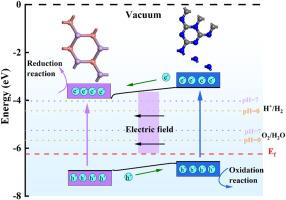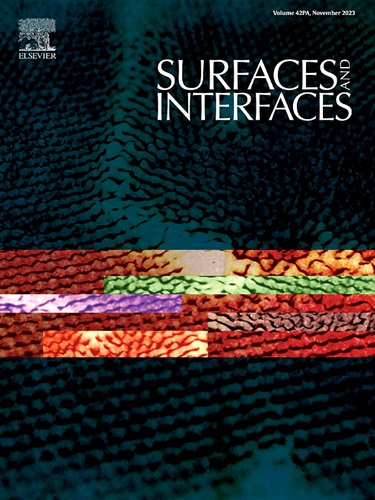构建新型β-XY(X = Ge、Sn,Y = S)/g-C3N4 异质结构:高效的可见光驱动型水分离催化剂
IF 5.7
2区 材料科学
Q2 CHEMISTRY, PHYSICAL
引用次数: 0
摘要
合理设计廉价、无污染且极其有效的光催化剂是实现清洁能源的关键一步。目前,太阳能-氢气(STH)转换效率(ηSTH)较低,使得制氢技术不够理想。在此,我们构建了新型的β-XY(X = Ge、Sn,Y = S)/g-C3N4 异质结构。通过 DFT 计算,对β-SnS/g-C3N4 的几何形状、光电特性及其反应的热力学可行性进行了深入研究。结果表明,β-SnS/g-C3N4 异质结构属于 II 型异质结构,其间接带隙为 2.57 eV。由于内置电场从 g-C3N4 单层延伸到 β-SnS 单层,有效地分离了电子和空穴,因此光催化效率更高。持续降低的自由能验证了水分裂的热力学自发性。此外,这种异质结构在可见光和紫外光范围内都有很强的吸收能力。值得注意的是,15.54% 的 ηSTH 值强调了这种材料的商业可行性。因此,这些研究结果表明,β-SnS/g-C3N4 异质结构是通过光催化实现水分离的理想候选材料。本文章由计算机程序翻译,如有差异,请以英文原文为准。

Construction of novel β-XY (X = Ge, Sn, Y = S)/g-C3N4 heterostructures: efficient visible light-driven water splitting catalysts
The logical design of inexpensive, non-polluting, and extremely effective photocatalysts is a crucial step toward achieving clean energy. The currently low solar-to-hydrogen (STH) conversion efficiency (ηSTH) makes hydrogen production technologies less than optimal. Herein, novel β-XY (X = Ge, Sn, Y = S)/g-C3N4 heterostructures have been constructed. Among them, the β-SnS/g-C3N4 exhibits low carrier recombination, and its geometry, optoelectronic properties, as well as the thermodynamic feasibility of its reaction, have been thoroughly examined through DFT calculations. The results demonstrate that the β-SnS/g-C3N4 heterostructure is a type-II heterostructure, exhibiting an indirect band gap of 2.57 eV. Photocatalysis is more efficient because of the built-in electric field that extends from the g-C3N4 monolayer to the β-SnS monolayer, effectively separating electrons and holes. The continuously decreasing free energy validates the thermodynamic spontaneity of water splitting. Additionally, the heterostructure demonstrates robust absorption in both the visible and UV ranges. Notably, the ηSTH of 15.54 % underscores the commercial viability of this material. These findings thus suggest that β-SnS/g-C3N4 heterostructure is a good candidate material for water splitting via photocatalysis.
求助全文
通过发布文献求助,成功后即可免费获取论文全文。
去求助
来源期刊

Surfaces and Interfaces
Chemistry-General Chemistry
CiteScore
8.50
自引率
6.50%
发文量
753
审稿时长
35 days
期刊介绍:
The aim of the journal is to provide a respectful outlet for ''sound science'' papers in all research areas on surfaces and interfaces. We define sound science papers as papers that describe new and well-executed research, but that do not necessarily provide brand new insights or are merely a description of research results.
Surfaces and Interfaces publishes research papers in all fields of surface science which may not always find the right home on first submission to our Elsevier sister journals (Applied Surface, Surface and Coatings Technology, Thin Solid Films)
 求助内容:
求助内容: 应助结果提醒方式:
应助结果提醒方式:


